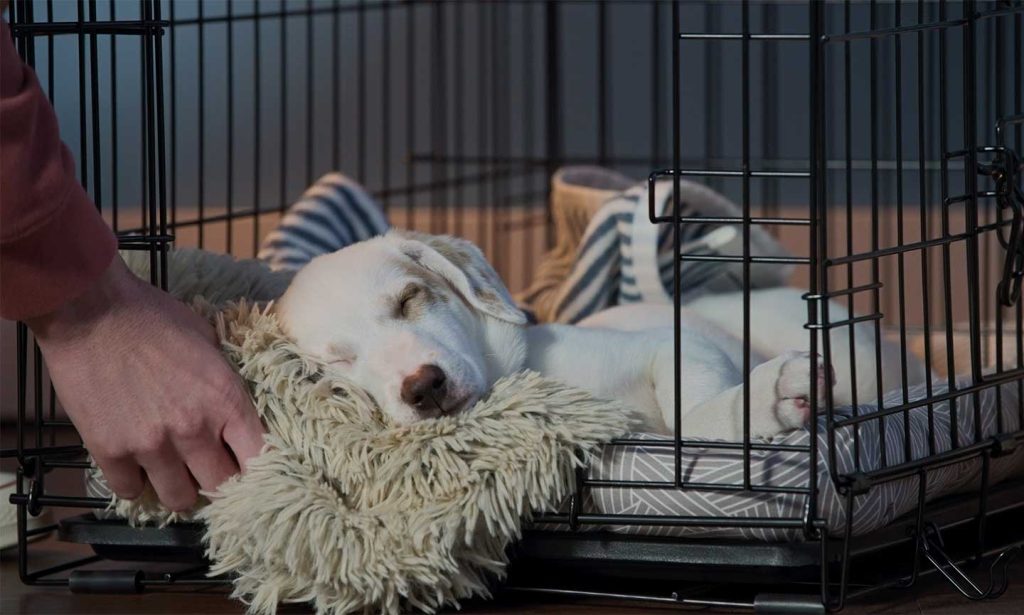So, it’s that time of the day again when you’re ready to catch some Z’s, but your furry friend seems to have endless energy. If you’re wondering how to communicate bedtime to your dog without resorting to a wrestling match or a seemingly never-ending game of fetch, you’re in luck. We’ve got some fantastic tips that will have your pup sleeping peacefully in no time. From establishing a bedtime routine to creating a cozy sleeping space, rest assured that with a little guidance, you and your four-legged companion can both enjoy a peaceful night’s sleep.

Establish a Bedtime Routine
Having a regular bedtime routine can greatly help in communicating to your dog that it’s time to sleep. Dogs are creatures of habit and thrive on routine, so establishing a consistent bedtime routine can be incredibly beneficial.
Choose a Consistent Time
The first step in creating a bedtime routine for your dog is to choose a consistent time to go to bed. Dogs thrive on routine and structure, so having a set time every night will help your furry friend understand when it’s time to wind down. Consistency is key, so try to stick to this schedule as closely as possible, even on weekends or during vacations.
Create a Calm Environment
Creating a calm and peaceful environment is essential for your dog to relax and prepare for sleep. Try to minimize noise and distractions in the surrounding area to help your dog feel secure and comfortable. Dimming the lights in the room can also signal to your dog that it’s time to wind down. Consider using calming scents, such as lavender, to promote a soothing atmosphere.
Incorporate Relaxing Activities
Incorporating relaxing activities into your dog’s bedtime routine can help them unwind and prepare for sleep. Gentle brushing or a calming massage can not only help relax your dog’s muscles but also provide a bonding experience between the two of you. You can also offer a puzzle toy or a stuffed Kong filled with treats or food to keep your dog occupied and mentally stimulated. Engaging in these activities will help your dog associate them with bedtime and induce a sense of relaxation.
Create a Comfortable Sleeping Space
Ensuring that your dog has a comfortable sleeping space is vital for them to have a good night’s sleep. By providing a cozy and inviting spot, you’ll make it easier for your furry friend to settle down and feel secure.
Choose an Appropriate Bed
Selecting the right bed for your dog is crucial in creating a comfortable sleeping space. Take into consideration your dog’s size, breed, and sleeping preferences. Some dogs prefer plush, soft beds, while others may favor a firmer surface. Allow your dog to try out different types of beds and observe which one they seem to enjoy the most. Providing a bed that caters to their individual needs will enhance their sleep quality.
Provide Adequate Bedding
In addition to choosing an appropriate bed, it’s important to provide your dog with adequate bedding. Comfortable blankets or pillows can help regulate their body temperature and create a cozy sleeping environment. Be sure to wash the bedding regularly to keep it clean and fresh, as dogs appreciate a clean sleeping area.
Ensure Good Temperature and Lighting
Maintaining a suitable temperature and lighting environment is essential for your dog’s comfort and quality of sleep. Ensure that the room is not too hot or too cold, as extreme temperatures can disrupt your dog’s sleep. Additionally, consider blocking out any excess light that may enter the room, as darkness promotes a more restful sleep. By creating the optimal sleeping conditions, you’ll help your dog relax and sleep better.
Use Clear Verbal Signals
Using clear and consistent verbal signals is a great way to communicate to your dog that it’s time for bed. By establishing a cue word and using a firm yet gentle voice, you can effectively convey your message.
Establish a Cue Word
Choose a word or phrase that you will consistently use to signal bedtime to your dog. Whether it’s “bedtime,” “sleepy time,” or a specific word of your choosing, using the same cue word consistently will help your dog understand the association with going to sleep. Use this cue word each night before or during your bedtime routine to reinforce its meaning.
Be Firm and Gentle in Your Voice
When using verbal signals, it’s important to strike a balance between being firm and gentle in your voice. Make sure your tone conveys authority and commands attention, but also maintain a soothing and calm demeanor. Dogs respond well to a confident but caring tone, so be sure to project that when communicating bedtime to your furry friend.
Repeat the Cue Word Consistently
Consistency is key when using verbal signals to communicate bedtime to your dog. Repeat the cue word multiple times during your bedtime routine and while settling your dog into their sleeping space. By consistently using the cue word, your dog will start to associate it with bedtime and understand what is expected of them.
Practice Positive Reinforcement
Positive reinforcement is a powerful tool when it comes to establishing a bedtime routine with your dog. By rewarding desired behaviors and creating positive associations, you can motivate and encourage your dog to follow the routine.
Use Treats and Rewards
Rewarding your dog with treats and rewards is a fantastic way to reinforce the desired bedtime behavior. When your dog follows the cue word or settles down in their sleeping space, offer them a small treat or a favorite toy as a reward. This positive association will encourage them to repeat the behavior in the future.
Praise and Petting
In addition to treats and rewards, praise and petting play a significant role in positive reinforcement. When your dog exhibits the desired bedtime behavior, shower them with praise, gentle pets, and affectionate words. Your dog will associate this positive attention with going to bed, making it a more enjoyable experience for them.
Link Bedtime with Positive Experiences
To strengthen the association between bedtime and positive experiences, consider incorporating additional enjoyable activities into your dog’s routine. For example, you can engage in a short training session or play their favorite game right before bedtime. By linking these positive experiences with the bedtime routine, your dog will look forward to this time of day and be more receptive to going to sleep.

Avoid Negative Reinforcement
Negative reinforcement, such as yelling or punishment, can have detrimental effects on your dog’s bedtime routine. It’s important to create a positive and supportive atmosphere to encourage your dog to follow the routine willingly.
Don’t Yell or Punish
Yelling or punishing your dog when it’s time for bed creates a negative association with bedtime. Instead of using harsh methods, opt for positive reinforcement techniques to motivate your dog. Yelling or punishment can cause anxiety and stress, making it more difficult for your dog to relax and sleep.
Avoid Making Bedtime Stressful
It’s crucial to avoid making bedtime a stressful experience for your dog. Minimize any potential stressors, such as loud noises, unfamiliar environments, or confrontations with other pets. By creating a calm, peaceful, and predictable routine, you’ll help your dog feel safe and secure, aiding in a smooth transition to sleep.
Maintain a Positive Atmosphere
Creating a positive atmosphere during the bedtime routine is vital for your dog’s overall well-being. Remain calm, patient, and positive throughout the process. Your attitude and energy will directly impact your dog’s behavior and perception of bedtime. By maintaining a positive atmosphere, you’ll set the stage for a successful and stress-free bedtime routine.
Limit Excitement Before Bed
To help your dog wind down before sleep, it’s important to limit activities that promote excitement or high energy levels. By minimizing vigorous play, noise, and distractions, you’ll create a peaceful atmosphere conducive to sleep.
Avoid Vigorous Play
Engaging in vigorous play, such as roughhousing or intense fetch sessions, right before bed can leave your dog feeling alert and energized. To avoid this, conclude any energetic activities at least an hour before bedtime. Instead, opt for calm and quiet activities that promote relaxation.
Minimize Noise and Distractions
To create a peaceful environment for bedtime, minimize noise and distractions in the surrounding area. Turn off the TV or any loud music, and ensure that the space is free from other pets or children. By reducing environmental stimuli, your dog will have an easier time focusing on winding down and preparing for sleep.
Engage in Calming Activities
Incorporating calming activities into your dog’s bedtime routine can help lower their energy levels and promote relaxation. Take a leisurely stroll or engage in light play that doesn’t trigger excitement. Activities such as scent work or obedience training that require focus can also help redirect your dog’s energy and prepare them for sleep.

Exercise Your Dog Regularly
Regular exercise is crucial for your dog’s overall well-being, including their sleep quality. By promoting physical activity and mental stimulation, you’ll tire out your dog, making it easier for them to settle down and sleep.
Promote Physical Activity
Engage in regular physical exercise with your dog to help burn off excess energy. The type and intensity of exercise will depend on your dog’s breed, age, and overall health. Activities such as walks, runs, or game sessions at the dog park can provide the necessary physical stimulation to tire out your furry friend.
Increase Mental Stimulation
Alongside physical exercise, mental stimulation is equally important. Mental activities, such as puzzle toys or obedience training, challenge your dog’s mind and keep them mentally engaged. This mental stimulation helps prevent boredom and enables your dog to relax more easily when it’s time to sleep.
Schedule Exercise Sessions Appropriately
To optimize sleep quality, schedule exercise sessions appropriately throughout the day. Engage in physical activity at least a few hours before bedtime to allow your dog’s energy levels to gradually decrease. This will help them wind down and be ready for sleep when bedtime arrives.
Consult with a Professional
If you’re facing difficulties establishing a bedtime routine with your dog, it can be beneficial to seek guidance from professionals who specialize in dog behavior and training. Their expertise can provide valuable insights and tailored solutions to address any challenges you may be facing.
Seek Guidance from a Dog Trainer
Consulting with a reputable dog trainer can be incredibly helpful in establishing a successful bedtime routine. A trainer can provide personalized guidance and assist you in identifying any underlying issues that may be hindering the process. Through positive reinforcement techniques and training exercises, a trainer can help you effectively communicate bedtime expectations to your dog.
Consider Behavioral Therapy
For more complex issues, behavioral therapy may be beneficial. A certified dog behaviorist can work closely with you and your dog to address any underlying behavioral issues or anxieties that may be interfering with your dog’s sleep routine. They will develop a customized plan to help your dog overcome these challenges and establish a healthier sleep pattern.
Discuss Bedtime Issues with a Vet
If your dog’s bedtime issues persist or are accompanied by other concerning symptoms, it’s crucial to discuss them with your veterinarian. Certain medical conditions or sleep disorders may be impacting your dog’s ability to sleep soundly. Your vet can perform a thorough examination, conduct any necessary tests, and provide appropriate treatment options to address the underlying issue.

Address Anxiety or Sleep Disorders
Anxiety or underlying sleep disorders can greatly impact your dog’s ability to settle down and sleep through the night. Identifying and addressing these issues is essential for their overall well-being and sleep quality.
Recognize Anxiety Symptoms
Anxiety symptoms can manifest in various ways in dogs, including restlessness, pacing, panting, excessive licking, or whining. If you notice any signs of anxiety during bedtime, it’s important to address them accordingly. Anxiety may stem from separation anxiety, noise phobias, or general anxiety disorders, and treating the underlying cause will help improve your dog’s sleep quality.
Implement Relaxation Techniques
Implementing relaxation techniques can be beneficial in reducing anxiety and promoting better sleep. Techniques such as massage, deep pressure therapy, or aromatherapy can help calm your dog’s nervous system. Additionally, playing soothing music or providing a calming, low-light environment can further aid in relaxation.
Consult a Veterinarian for Diagnosis
If anxiety or sleep disorders are suspected, it’s recommended to consult with a veterinarian for proper diagnosis and treatment. They will be able to assess your dog’s symptoms, conduct any necessary tests, and provide appropriate medications or behavioral therapies to alleviate anxiety or sleep-related issues.
Be Patient and Consistent
Establishing a successful bedtime routine with your dog takes time, patience, and consistency. By setting realistic expectations and maintaining a consistent routine, you’ll pave the way for improved sleep habits and a better night’s rest for both you and your furry companion.
Set Realistic Expectations
It’s important to set realistic expectations when establishing a bedtime routine with your dog. Each dog is unique, and some may require more time or support to adjust to the routine. Be patient and understanding throughout the process, and remember that progress may occur gradually.
Maintain a Consistent Bedtime Routine
Consistency is the foundation of a successful bedtime routine. Stick to the established schedule, cues, and activities to reinforce your dog’s understanding of bedtime. By maintaining a consistent routine, your dog will soon come to anticipate and embrace the nightly routine.
Monitor Progress and Make Adjustments
Monitor your dog’s progress and be attentive to any changes or challenges that arise. If certain aspects of the routine are not working effectively, don’t be afraid to make adjustments. Observe your dog’s behavior and make modifications as needed to ensure that they are comfortable and receptive to the routine.
In conclusion, effectively communicating bedtime to your dog requires the establishment of a consistent routine, the creation of a comfortable sleeping space, the use of clear verbal signals, positive reinforcement techniques, the minimization of excitement before bed, regular exercise, seeking professional guidance when necessary, addressing anxiety or sleep disorders, and maintaining patience and consistency throughout. By implementing these strategies and providing a supportive environment, you can help your dog develop healthy sleep habits, ensuring they wake up refreshed and ready to face the day with vigor.





